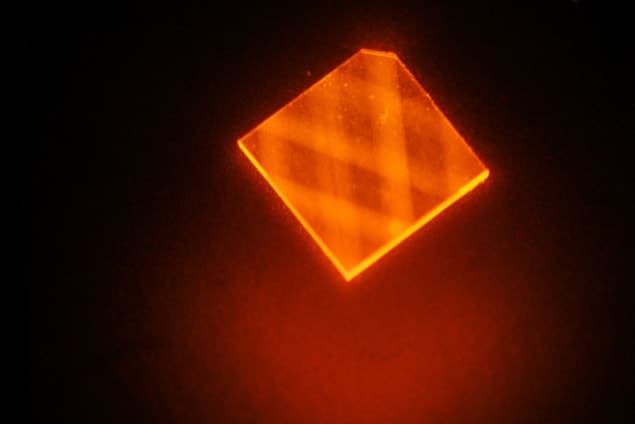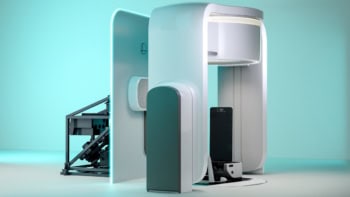
A new type of magnetometer based on diamond impurities has been unveiled by physicists in the US. The device is about 1000 times more sensitive than previous diamond-based sensors because it uses an optical cavity to concentrate laser light in the vicinity of the impurities. Although the new device cannot yet reach the sensitivity of some other types of magnetometers, the physicists believe that it offers significant practical advantages that will be useful to researchers in many fields, including those studying magnetic signals from the heart and brain.
The most precise magnetometers available today are superconducting quantum interference devices (SQUIDs) and atomic magnetometers, both of which can measure magnetic fields in the femtotesla range. However, the most sensitive SQUIDs must be operated at temperatures near absolute zero and atomic magnetometers need expensive and unwieldy vacuum and field-nulling systems. Sensors based on diamond impurities have the potential to be much more user-friendly because they use robust pieces of diamond and work at ambient pressures and temperatures. The devices make use of nitrogen vacancy (NV) centres, which occur when two adjacent carbon atoms in a diamond lattice are replaced by a nitrogen atom and a lattice vacancy. NV centres emit red light when excited by green light and the wavelength of this emitted light is shifted by the presence of an external magnetic field. Magnetic-field strength can be determined by measuring this shift and NV centres offer the added bonus of also being sensitive to small variations in relatively high fields.
Huge diamonds needed
Making a practical sensor remains a challenge, however, because NV centres are very weak absorbers of light. This means that the green light would need to travel about 1 m through a diamond to create enough red light to make a meaningful measurement. This distance could be decreased by using a diamond with a very high density of NV centres, but this would result in lower precision because the NV centres would interfere with each other.
Producing a 1 m-long diamond would be both difficult and expensive, so Dirk Englund and colleagues at the Massachusetts Institute of Technology took a different approach by having the green light bounce back and forth many times through a much smaller diamond. Their first attempt involved attaching special mirrors to the sides of a diamond to create an optical cavity. “We tried for close to a year and a half unsuccessfully,” says Englund. “We also realized that, even if we did make such a cavity, it’s relatively difficult to lock a laser to it – you’d have to have a specialized laser stabilized on a very narrow frequency.”
Sparkling reflections
After this setback, the team realized that the diamond itself could act as the cavity. Diamonds are prized by jewellers precisely because they have a high refractive index, which causes light to bounce around inside them by total internal reflection and makes them sparkle. By injecting green light into a faceted edge of the diamond at a well-chosen angle, the researchers could make the light travel up to 1 m inside a diamond just 3 mm in length – with almost all the green light being absorbed along the way. As a result, a simple diode laser the size of a fingernail can be used to supply the green light. “It’s quite possible we should have thought of it first,” jokes Englund.
The researchers used their device to measure magnetic fields that varied at a frequency of 1 Hz and achieved a sensitivity of a few picotesla – about three orders of magnitude less sensitive than the best SQUIDs. The team is now looking at how to improve the sensitivity further by collecting the emitted light more efficiently. “There are definitely a few orders of magnitude to go,” says Englund. At current or slightly improved sensitivity, the device could be useful for investigating the electrical activity of the heart or brain.
“The NV centre is a relatively new area that’s only been around for five or 10 years,” says Mike Romalis of Princeton University in New Jersey. He adds that Englund’s sensor is interesting because it is somewhat more practical than other NV devices and also because it works with low-frequency magnetic signals where a lot of practical magnetic fields exist. The absolute accuracy of the sensors is currently below that of atomic magnetometers of similar size, he says, but their ability to operate at ambient conditions is a big advantage for investigating living tissues.
The research is published in Nature Physics.



